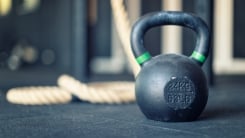A Guide to Buying Your First (or Next) Kettlebell

So you’ve read about my favorite kettlebell exercises for beginners and you’d like to start doing them at home. Or perhaps you already have a few bells, and you’re thinking it’s time to get another—maybe something heavier, if you started out too light. The world contains multitudes of kettlebell options, from rainbow-colored competition bells to cast iron hardstyle bells to the molded plastic things you can buy at, say, a Five Below. Let’s dissect the kettlebell market so you can pick the best bells for your needs.
And, yes, kettlebells are commonly called “bells.” They’re also frequently labeled in kilograms rather than pounds, even in the U.S., but that will depend on the type of bell you’re looking at.
The difference between kettlebell types
In the modern fitness world, there are three types of kettlebells. Before you go much further in your shopping journey, you’ll have to figure out which type makes sense for you. I’ll say more about each, but here’s the basic roadmap.
-
Cast iron or “hardstyle” kettlebells are usually black in color, and vary in size and shape. The heavier the bell, the bigger the round part is. These are used most often by people who do “hardstyle” kettlebell training, which I’ll say more about in a bit.
-
Competition kettlebells are designed to be the same size regardless of weight, so even the lightest bells will be roughly the size of a bowling ball. They are sold in kilograms (usually multiples of 4 or 8) and are color coded. A 16 kg bell, for example, will be yellow. These are used in a strength sport known as kettlebell sport or girevoy sport, where competitors race to get the most reps of a given lift in a 10-minute time period.
-
Fitness kettlebells, for lack of a better term, are the miscellaneous bells you’ll see at gyms or stores that don’t really specialize in kettlebells. They might be plastic, or vinyl-coated, and the shape may or may not be something comfortable to hold.
Personally I think competition kettlebells are the best kind to work with, but I’ve competed in kettlebell sport, so I’m biased. There’s nothing wrong with hardstyle bells, if you like them or are used to them. (I think they’re less comfortable to hold, but that’s a preference rather than a dealbreaker.) The fitness kettlebells are a chaotic bunch, though: I’ve used chrome-and-plastic ones that I almost like as much as my favorite comp bells, and I’ve also seen oddly-shaped monstrosities that are pretty much impossible to work with. As a category, I’d shy away. But if you do manage to find a fitness bell you enjoy working with, don’t let me stop you.
Below, I’ll give my picks for some good bells in each of my favorite categories, and I’ll discuss the pros and cons of those types. But first, I know there’s a burning question on your mind: how heavy?
What kettlebell weight should I start with?
I don’t believe in the idea that there is a single “correct” weight to start with. I mean, you wouldn’t walk into a gym, see a rack of dumbbells, and assume you’d only work with one pair of dumbbells for your first few months, would you?
But it’s common to start with one kettlebell, so people want a single recommendation. I’m okay with this, so long as you understand that you want a heavy kettlebell for swings, and a light one for presses and snatches.
For the lighter kettlebell, we can go with the standard recommendations you’ll see in kettlebell books and forums. This should give you a bell that you can press overhead, or that (once you learn the technique) you can snatch. Very generally, you can go with:
-
8 kg (about 18 pounds) if you are a small person and/or inexperienced with strength training
-
12 kg (about 26 pounds) if you fall in between the above and below descriptions
-
16 kg (about 35 pounds) if you are experienced with strength training
-
Or try this test: If you have access to dumbbells or kettlebells (even in a store), find a weight that you can press overhead multiple times.
Feel free to go higher or lower than these examples. Often you’ll hear a recommendation that women should start with 8 to 12 kg, and men should start with 12 to 16. But this is really a recommendation that should be based on strength, not gender; plenty of women would do fine with a 16 as their first bell. And there are people of all genders who might be better off with something lighter than an 8, or heavier than a 16. Which is why I recommend that people experiment with various bells to see what makes sense. If you train with dumbbells, you can use your usual weight for a single-hand dumbbell press to guide your choice here.
For your heavier kettlebell, you want a bell that is so heavy you cannot press it. I have some guidelines here on finding the perfect weight for a heavy bell that you can swing. Somewhere between a 24 (53 pounds) and a 32 (70 pounds) will be a good starting place for most beginners. You can certainly go heavier than a 32 though. And you can swing your lighter bell, but I’d recommend learning to swing with a heavy bell first. The weight is instructive.
The best cast iron or “hardstyle” kettlebells
Cast iron kettlebells are a good first choice for many people, because they are cheap and durable. They’re available in a range of weights, including heavy ones. My first kettlebells were hardstyle, and they were perfectly good to train with.
“Hardstyle” is a nickname for a type of kettlebell training that commonly uses these bells. Probably most of the kettlebell exercises you’ve seen in a gym are versions of this. There are swings, windmills, presses, Turkish get-ups, and more. The swings are often done with two hands on the same bell, and exercises are done in sets and reps (as opposed to kettlebell competition training, which uses timed sets). You can do these exercises with any type of bells, so don’t feel like you need to use cast iron—but that is the more common type.
The main disadvantages of cast iron kettlebells come down to the shape. Unlike competition bells, which are uniform in shape and size no matter the weight, cast iron bells are each shaped differently. At smaller weights, a large handle has to angle itself downward into a baseball-sized lump of iron. At larger weights, the main part of the bell is maybe the size of a bowling ball (or bigger!) and the handle had better be able to support it. You might learn how to hold a 12 kg bell comfortably enough to press it, but then you move up to a 16 kg bell, and suddenly everything is different and you need to re-learn your technique.
When buying cast iron kettlebells, check that the entire bell is cast in one piece (a welded-on handle is a liability) and make sure the handle is comfortable. Your hand will rub against the handle whether you’re swinging, cleaning, or adjusting your grip mid-snatch, so make sure there are no jagged edges. If the bell feels good to use, enjoy! Here are some hardstyle bells you might like:
$137.99
at Amazon


$137.99
at Amazon

$50.99
at Amazon


$50.99
at Amazon

$25.09
at Amazon


$25.09
at Amazon

$69.99
at Amazon

$69.99
at Amazon
The best competition kettlebells
The advantages and disadvantages of competition bells are just those of hardstyle, but swapped. They tend to be more expensive, but they’re uniform in shape so the different weights will feel very similar in your hand. Kettlebell sport practitioners work on the efficiency of their technique, so once you learn the exact place to put your elbow in a clean position (for example), you’ll be able to replicate that even when you change weights.
That said, brands still vary slightly in size and shape. You might prefer one brand’s “window” (the hole in the handle) to another—maybe it’s a bit wider or more square shaped. There are also competition-style bells with indentations where your forearm goes during overhead lifts. I also have one more preference when it comes to competition bells: they should stick with standard color coding! Pink for 8 kg, yellow for 16, green for 24, red for 32, and so on. Some brands (coughTitancough) have begun offering their competition style bells in non-standard colors, and I am mad about it. But in your own home gym, I suppose you can lift any color bell you like. Here are some picks:
$77.97
at Amazon

$77.97
at Amazon
$249.99
at Amazon

![Adjustable Kettlebell [Bells of Steel] Upgraded Version Kettlebell Adjustable | Steel Shell, Internally-Loaded for Full Body Workouts | Competition Standard 35mm Handle, 12-20.5kg](https://lifehacker.com/imagery/product/04iIShFrFDAhepWxmNM75AD/hero-image.fill.size_autoxauto.v1720031287.jpg)
$249.99
at Amazon

$109.95
at Amazon

$109.95
at Amazon



